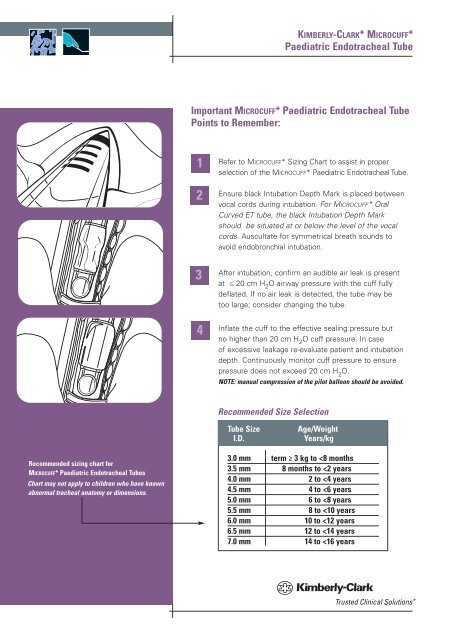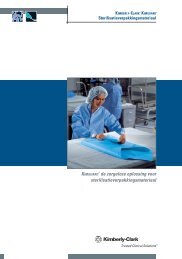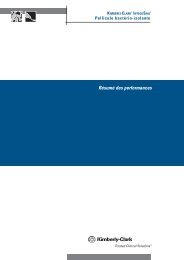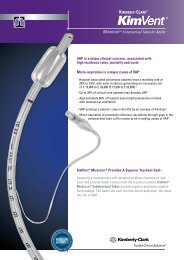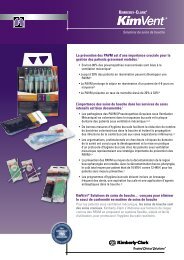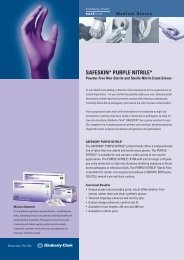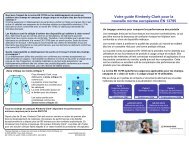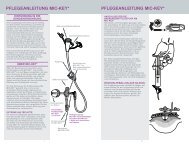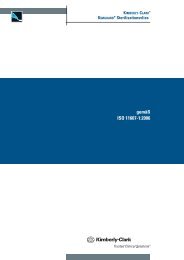Paediatric Endotracheal Tube Important ... - Digestive Health
Paediatric Endotracheal Tube Important ... - Digestive Health
Paediatric Endotracheal Tube Important ... - Digestive Health
Create successful ePaper yourself
Turn your PDF publications into a flip-book with our unique Google optimized e-Paper software.
HC622-01-UK 12/10/06 12:03 Page 1<br />
KIMBERLY-CLARK* MICROCUFF*<br />
<strong>Paediatric</strong> <strong>Endotracheal</strong> <strong>Tube</strong><br />
<strong>Important</strong> MICROCUFF* <strong>Paediatric</strong> <strong>Endotracheal</strong> <strong>Tube</strong><br />
Points to Remember:<br />
1<br />
2<br />
3<br />
4<br />
Refer to MICROCUFF* Sizing Chart to assist in proper<br />
selection of the MICROCUFF* <strong>Paediatric</strong> <strong>Endotracheal</strong> <strong>Tube</strong>.<br />
Ensure black Intubation Depth Mark is placed between<br />
vocal cords during intubation. For MICROCUFF* Oral<br />
Curved ET tube, the black Intubation Depth Mark<br />
should be situated at or below the level of the vocal<br />
cords. Auscultate for symmetrical breath sounds to<br />
avoid endobronchial intubation.<br />
After intubation, confirm an audible air leak is present<br />
at ≤ 20 cm H 2 O airway pressure with the cuff fully<br />
deflated. If no air leak is detected, the tube may be<br />
too large; consider changing the tube.<br />
Inflate the cuff to the effective sealing pressure but<br />
no higher than 20 cm H 2 O cuff pressure. In case<br />
of excessive leakage re-evaluate patient and intubation<br />
depth. Continuously monitor cuff pressure to ensure<br />
pressure does not exceed 20 cm H 2 O.<br />
NOTE: manual compression of the pilot balloon should be avoided.<br />
Recommended Size Selection<br />
<strong>Tube</strong> Size<br />
I.D.<br />
Age/Weight<br />
Years/kg<br />
Recommended sizing chart for<br />
MICROCUFF* <strong>Paediatric</strong> <strong>Endotracheal</strong> <strong>Tube</strong>s<br />
Chart may not apply to children who have known<br />
abnormal tracheal anatomy or dimensions.<br />
3.0 mm term ≥ 3 kg to
HC622-01-UK 12/10/06 12:03 Page 2<br />
KIMBERLY-CLARK* MICROCUFF*<br />
<strong>Paediatric</strong> <strong>Endotracheal</strong> <strong>Tube</strong><br />
Directions for use: Use aseptic technique.<br />
Intubation and extubation should be performed following<br />
currently accepted medical techniques.<br />
1. Expert clinical judgment should be used in choosing the suitable<br />
endotracheal tube size and style for each patient.<br />
2. Remove the sterile MICROCUFF* <strong>Endotracheal</strong> <strong>Tube</strong> from its<br />
protective package. Test the cuff, pilot balloon and valve of each<br />
tube by inflation prior to use. Insert a luer tip syringe into the cuff<br />
inflation valve housing and inject enough air to fully inflate the cuff.<br />
3. After test inflation, completely evacuate the air.<br />
4. If pre-cutting of the tracheal tube is considered, evaluate suitability<br />
of the tube for pre-cutting prior to intubation. If the tube is pre-cut,<br />
it should be cut at a slight angle to facilitate reinsertion of the<br />
15 mm connector into the tube. Always assure the connector is firmly<br />
seated in both the tracheal tube and the breathing circuit to prevent<br />
disconnection during use.<br />
5. In those situations where it is deemed appropriate to pre-cut the<br />
tube, the user is cautioned that anatomical variations, conditions<br />
of use or other factors may result in a tracheal tube either too<br />
long or too short for a given patient when the standard pre-cut<br />
length indicated on the tube is used. Expert clinical judgment<br />
should be used in selecting the appropriate tube size and pre-cut<br />
length.<br />
6. Intubate the patient following currently accepted medical<br />
techniques with consideration given to the specific cuff-related<br />
WARNINGS and PRECAUTIONS stated in the product insert.<br />
MICROCUFF* <strong>Paediatric</strong><br />
<strong>Endotracheal</strong> <strong>Tube</strong> Magill<br />
KIMBERLY-CLARK* MICROCUFF* <strong>Paediatric</strong><br />
<strong>Endotracheal</strong> <strong>Tube</strong> is just one of the clinical<br />
solutions that you can depend on to meet<br />
the demands of your fast-paced world.<br />
Whether your needs involve preventing<br />
healthcare-associated infections, surgical<br />
and digestive solutions or pain management,<br />
with Kimberly-Clark you’ll always have one<br />
less worry<br />
Commitment to Excellence<br />
If, for any reason, our products do not meet your<br />
expectations, please let us know your comments<br />
or suggestions for improvement. Your input will<br />
result in a concerted effort on our part to meet your<br />
requirements. Our goal is to provide quality products<br />
that completely meet your needs time after time.<br />
For more information, please call your Kimberly-Clark representative<br />
or visit our web site at www.kchealthcare.com/microcuff.<br />
*Registered Trademark or Trademark of Kimberly-Clark Worldwide, Inc.<br />
or its affiliates. ©2006 KCWW. All rights reserved.<br />
HC622/01-UK KLM-166 H8346<br />
Kimberly-Clark N.V. Belgicastraat 13, 1930 Zaventem, Belgium. Distributed in<br />
the U.S. by Kimberly-Clark Global Sales, Inc., Roswell, GA 30076 USA<br />
In USA call 1-800-528-5591; International call 1-801-572-6800<br />
www.kchealthcare.com<br />
7. Once the patient is intubated, inflate the cuff only with enough<br />
gas mixture to provide an effective seal at the desired lung<br />
inflation pressure. The use of Minimal Occluding Volume,<br />
Minimum Leak techniques and monitoring (measuring) of cuff<br />
pressure can help reduce the occurrence of many of the adverse<br />
reactions associated with the use of cuffed tracheal tubes.<br />
8. Remove syringe from the valve housing after cuff inflation.<br />
Leaving the syringe attached will keep the valve open, permitting<br />
the cuff to deflate.<br />
9. Check to verify inflation system is not leaking. Integrity of the<br />
system should be verified periodically during intubation period.<br />
Uncorrected failure of the inflation system could result in death.<br />
Cuff pressure should be closely monitored and any deviation<br />
from selected seal pressure should be investigated and corrected<br />
immediately.<br />
10. Prior to extubation, deflate cuff by inserting syringe into valve<br />
housing and removing gas mixture until a definite vacuum is<br />
noted in the syringe and the pilot balloon is collapsed.<br />
11. Extubate the patient following currently accepted<br />
medical techniques.<br />
12. Discard the tracheal tube.<br />
1 Dullenkopf, A., C. Gerber and M. Weiss, Fit and Seal Characteristics of a New<br />
<strong>Paediatric</strong> Tracheal <strong>Tube</strong> with High Volume-low Pressure Polyurethane Cuff.<br />
Acta Anaesthesiol Scand 2005; 49:232-237


